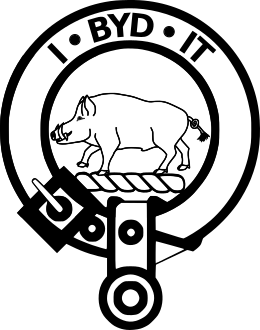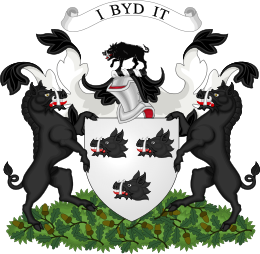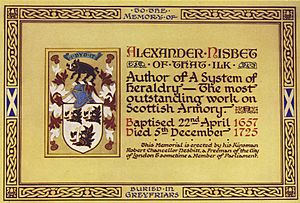Clan Nesbitt facts for kids
Quick facts for kids Clan Nesbitt or Nisbet |
|||
|---|---|---|---|

Crest: A boar passant Sable, armed Argent, langued Gules
|
|||
| Motto | I Byd It (I endure) | ||
| Slogan | "A Nisbet" | ||
| Profile | |||
| Region | Borders | ||
| District | Berwickshire | ||
| Plant badge | Oak | ||
| Chief | |||
 |
|||
| Mark Nesbitt of that Ilk | |||
| Chief of Clan Nesbitt | |||
| Historic seat | Nisbet House | ||
|
|||
The Clan Nesbitt (also known as Clan Nisbet) is a historic Scottish family from the Scottish Borders. It is officially recognized by the Lord Lyon King of Arms, who is the head of heraldry in Scotland.
Contents
History of Clan Nesbitt
Where the Nesbitt Name Comes From
The Nesbitt name comes from a place called Nesbitt, near Edrom in Berwickshire, Scotland. This area was likely named after a natural feature, like a hill shaped like a nose. A famous expert on Scottish family symbols, Alexander Nisbet (1657–1725), helped make the name well-known. He wrote that the Nesbitt lands were very old. They were given to monks by King Edgar around the year 1100. This was to pray for his father, Malcolm Canmore.
Records show that William de Nesbite was a witness to an important document around 1160. Later, Thomas Nisbet was a leader at Coldingham Priory from 1219 to 1240.
Fighting for Scottish Independence
In 1296, several Nesbitt family members, including Philip de Nesbit, signed the Ragman Rolls. This meant they agreed to be loyal to Edward I of England. However, Adam Nisbet later received land from Robert the Bruce. In return, he had to provide a knight for the king's army. Adam, or his son, continued to serve David II of Scotland by defending the Scottish Borders.
The 1400s and 1500s
After Adam, Philip Nisbet became the family leader. He was mentioned in important documents of the Earls of Dunbar. Philip's son was also named Adam. Many years later, another Philip Nisbet married a daughter of the Clan Haldane family. Their son was Alexander Nesbit.
The 1600s and the Civil War
Alexander Nesbit was a strong supporter of Charles I of England. He became the sheriff of Berwickshire. When the king's decisions led to war, Alexander and his sons joined the king's side.
Alexander's oldest son, Philip, was made a knight and led a group of soldiers. He helped defend Newark-on-Trent during a long battle. After leaving Newark, Philip joined James Graham, 1st Marquess of Montrose. Montrose's army was surprised at the Battle of Philiphaugh. Philip Nesbit was captured there and later executed in Glasgow in 1646. Two of Philip's brothers, Alexander and Robert, also died during the Scottish Civil War. The youngest brother, Adam, survived. He was the father of the famous writer on heraldry, Alexander Nisbet.
The 1700s and 1800s
Alexander Nisbet first studied to be a lawyer. But he soon became very interested in history and heraldry (the study of coats of arms and family symbols). In 1702, he published his first book. His most important work was System of Heraldry, which came out in 1722. This book was so popular that it was printed again many times. Alexander Nisbet passed away in 1725.
Nesbitt Family Branches
Over time, different parts of the Nisbet family settled in other places. These included Dean in Edinburgh, Dirleton in East Lothian, and Greenholm in Ayrshire. In the 1600s, many Nisbets moved to Ireland. From there, some traveled to North America.
Clan Tartan
The Nesbett tartan is very similar to the Mackintosh tartan. It also looks like the Dunbar pattern. These patterns appeared in a book called the Vestiarium Scoticum. However, there is no real historical connection between the Nesbitts and Clan Mackintosh. The Vestiarium was actually a book created in the Victorian era (1842) that was later found to be a forgery. Even so, many of today's clan tartans are still based on the designs from this book.
Clan Chief
For four centuries, the clan did not have a recognized chief. This was because the Nesbitt lands were lost during the Civil War. In 1994, the Lord Lyon officially recognized Robert Anthony Ellis Nesbitt as the Chief of the Name and Arms of Nesbitt (or Nisbet). After he passed away in 2000, his son, Mark Nesbitt (born in 1961), became the current Chief.
Clan Profile
- Arms: A silver shield with three black boar heads, with silver tusks and red tongues.
- Crest: A black boar walking, with silver tusks and a red tongue.
- Motto: I byde it (This means "I endure it" or "I stand by it").
- Plant badge: Oak
Clan Castles and Lands
- Nisbet Castle, Berwickshire
- Nisbet House, Nisbet, Berwickshire
- Dirleton Castle, bought in 1663 by lawyer John Nisbet. It was already a ruin then. Nisbet built his country home, Archerfield, nearby.
Different Ways to Spell Nesbitt
Nesbitt, Nesbit, Nisbet, Nisbett, Nisbeth (in Sweden and Denmark), Naisbitt, Nezbeth
Clan Society
The Nesbitt/Nisbet Society was started in 1980 by Professor John A. Nesbitt. There are branches in the British Isles, North America, and Australia. These branches work together and have over 400 families as members. They organize gatherings, often in places important to the family's history. Membership is open to anyone interested in the family, whether they are related or not.


